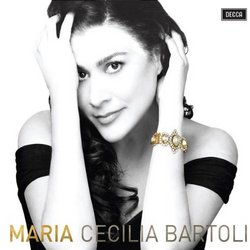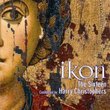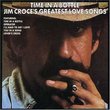| All Artists: Maria Maribran, Vincenzo Bellini, Jacques Fromental Halevy, Giovanni Pacini, Felix Mendelssohn, Manuel Garcia, Adam Fischer, Orchestra 'La Scintilla', Cecilia Bartoli, Luca Pisaroni Title: Cecilia Bartoli - Maria Members Wishing: 2 Total Copies: 0 Label: Decca Original Release Date: 10/16/2007 Re-Release Date: 10/10/2006 Album Type: Limited Edition Genres: Special Interest, Pop, Classical Styles: Vocal Pop, Opera & Classical Vocal, Forms & Genres, Concertos, Historical Periods, Classical (c.1770-1830) Number of Discs: 1 SwapaCD Credits: 1 UPC: 028947590774 |
Search - Maria Maribran, Vincenzo Bellini, Jacques Fromental Halevy :: Cecilia Bartoli - Maria
 | Maria Maribran, Vincenzo Bellini, Jacques Fromental Halevy Cecilia Bartoli - Maria Genres: Special Interest, Pop, Classical
Cecilia Bartoli revisits the early Romantic era of Rossini, Bellini and their contemporaries and views the Bel canto glory days through the eyes of Maria Malibran: Romantic icon, Bel Canto muse, and the most extraordinary ... more » |
Larger Image |
CD DetailsSynopsis
Album Description Cecilia Bartoli revisits the early Romantic era of Rossini, Bellini and their contemporaries and views the Bel canto glory days through the eyes of Maria Malibran: Romantic icon, Bel Canto muse, and the most extraordinary opera star of her time. Maria features 8 world premiere recordings including the prayer `Se il mio desir...Cedi al duol' from the long lost opera Irene by Pacini, and the aria `E non lo vedo...Son regina' by Maria's father, the famous Rossini tenor Manuel Garcia. Bartoli also presents the London version of Mendelssohn's `Infelice' for voice, violin solo and orchestra, where she duets with Maxim Vengerov. The album also includes popular favorites, such as Bellini's `Casta Diva' from Norma. Maria features an incredible variety of music. Mellifluous Bel canto delights are contrasted with regional flavors from around the world: from Spanish flamenco to Tyrolienne yodeling. The album exhibits Cecilia Bartoli singing in four languages: Italian, Spanish, French and English. She is joined by the period practice Orchestra La Scintilla, led by Hungarian conductor Adam Fischer. Similarly Requested CDs
|
CD ReviewsThe soul of bel canto C. Pacheco | 10/16/2007 (5 out of 5 stars) "Maria Malibran was the first true Diva of opera, not just of bel canto. Her traumatic childhood, her flexible octave range, her incredible coloratura and her beauty made her a larger than life personality in the early 19th century. Maria was a natural contralto, but thanks to the training she received by her iron fisted father (Rossini's favorite tenor, Manuel Garcia) she developed a vocal range of over 3 octaves (low D to D or E above high C) while keeping the dark timbre throught her range. In this collection of arias we get a beautiful example of what this Diva was capable of, and of course many of these pieces are virtual unknowns that didn't survive in popularity during the verismo period but they are absolutely stunning. This album could be described as a jewel box, each song is a precious stone. I believe this is Cecilia's most beautiful and elegant work to date, each song is a good example of bel canto. Cecilia's 3+ range fits perfectly in this repetoire, and as always she did it all historically correct using La Malibran's ornamentation whenever possible. The first 4 arias showcase what bel canto is all about, a pure attack of the pitch, smooth legatto and graceful coloratura, no forced high notes (even on the high C's) and no cackling on the coloratura. "Yo soy el contrabandista" is an enjoyable example of the compositions by Manuel Garcia and also suits Cecilia's love for flamenco. The scene from "La sonnambula" is absolutely beautiful and historically correct (since it was originally written for the mezzo voice). In track 16 Cecilia shows us her low register (possibly the lowest I've heard her go, to low E) and in tracks 9 and 11 she showcases her upper register in solid high C's. It must be mentioned this recording is tuned to A-432, the historical tuning of bel canto...and it truly pays off. For any bel canto lover, opera lover or art lover this is a MUST! " A fascinating concept that is implemented well Steven A. Peterson | Hershey, PA (Born in Kewanee, IL) | 11/07/2007 (5 out of 5 stars) "The concept is intriguing: mezzo soprano Cecilia Bartoli takes a shot at the works associated with the great (if short-lived) opera singer Maria Malibran (1808-1836). Accompanying the CD is a DVD that provides context about the making of this CD and about the larger context. There is also a nice book that provides additional context (including information about Maria Malibran, pictures of Malibran artifacts, words to songs/arias, etc.). In the end, though, it's the music. . . . An intriguing array of works. The composers whose work Malibran sang included her father, Manuel Garcia, lesser known composers such as Johann Hummel, Giuseppe Persiani, Malibran herself, Vincenzo Bellini, and so on. An intriguing set of works. More interesting: from what I can tell, one of these, from Bellini's "I Puritani," uses Malibran's own version as the template. Some examples. . . . She begins with "Si un mio desir" from Pacini's "Catania." Her low voice provides a rich tone to this piece. She also displays a pretty competent trill. Bartoli's version of Malibran's father's work, "Yo que soy contrabandista," is intriguing. The guitar backing is pleasing. Bartoli's lustrous voice serves this work well. She shows a fair amount of vocal agility here. Then, something most interesting. She takes on Bellini's "Ah! non credea mirarti" and the accompanying cabaletta "Ah! non giunge." Normally this is associated with the high flying coloratura sopranos. One expects a Sutherland or a Jo or a Sills to take this on. But, the book convincingly argues, this was the territory of mezzos in Bellini's time (Malibran, apparently, could sing the mezzo range). And the lower tone of Bartoli provides a refreshing approach. Her version of the cabaletta sure sounds afar from the sopranos, but she makes it work. She takes this at a brisk pace, not as heavily ornamented by the leading coloratura sopranos of recent decades. Nonetheless, it is an interesting version. The repeat is more florid, and her deeper voice adds a compelling touch, at least from my listening. She displays considerable agility here. Then, there is Malibran's own "Rataplan" (composed in 1836, the year of her death at a young 28). This air begins with drums. This is a lively tune, and Bartoli handles the pace and effects composed by Malibran well. What does one not think of when thinking of a mezzo? "Vien diletto" from Bellini's "I Puritani." Again, we think of Sutherland and other coloratura sopranos. Here, Bartoli sings Malibran's own version of this cabaletta. I'm not sure that I'm completely enchanted with Malibran's version (portrayed by Bartoli), but approaches have obviously changed over time. And this picture from the past is pretty satisfying. The pace is quite a bit slower than what most of us will be used to. But the sound of a rich mezzo taking this on is something that makes one think again about approaches to this piece. And so on. . . . The CD closes with Bartoli's rendition of "Casta Diva" from Bellini's "Norma." Suffice it to say that this is another interesting rendition of a work that is not normally thought of as within the ambit of a mezzo soprano. This is really an interesting CD (with accompanying book and DVD to make this a bargain, in my view). If you accept the underlying concept, I'm pretty sure that most listeners will find this a very special offering. " I DON'T GET IT John J. Schauer | Chicago, IL USA | 02/20/2008 (3 out of 5 stars) "We should all be glad that Cecilia Bartoli has such clout in the world of classical music, because without it, we wouldn't have such interesting recordings as this one or her earlier Salieri album. Here she explores repertoire associated with the legendary 19th-century singer Maria Malibran (terms such as soprano and mezzo-soprano weren't as rigorously applied then as they are now; scholars surmise that she was basically a mezzo with a freakishly high extension that enabled her to tackle many of what today are considered soprano roles.) I suppose the implication is that Ms. Bartoli is today's equivalent of Malibran, but I think not.
I've never understood the Bartoli phenomenon. Lord knows enough knowledgeable people are in awe of her talent--I remember one vocal authority, after hearing one of her first recitals, declared her to be "a perfect singer." I never heard her live (maybe that's the only way to appreciate her gifts), but I remember the first time I heard one of her recordings on the radio. Not knowing who was singing, I was curious as to just who it was who had such a strange-sounding voice and technique. I was shocked to learn that it was this supposedly "perfect" singer. For starters, her voice, to my ear, is not beautiful or sensuous. It often exhibits a guttural, almost shrill tone that makes her sound old and which I find grating. She's an attractive woman, but when she sings (as is painfully obvious in her video performances), she grimaces and contorts her mouth in a most unattractive and distracting manner. I also find her emotional range to be limited. She seems to have two modes: a soft, admittedly beautiful, legato that seems to indicate quiet introspection; and a breathy declamation that connotes agitated distress. In the Mad Scene from "I Puritani," for example, I hear no sadness in what must be the most heart-breaking set piece Bellini ever composed. And her coloratura!--It sounds like a cross between gargling and hiccoughs. Unfortunately, for the repertoire she most frequently performs, coloratura facility is a requirement. (I was once at a book signing for Dame Joan Sutherland, who was asked her opinion of Bartoli. She tried to be tactful, but said, "I must say her coloratura production sounds very strange. It will be interesting to see how long she's around." Well, Bartoli is obviously still around, but she also still has that strangely cackling coloratura sound.) One wonders why no teacher or coach ever told her not to aspirate each note so strongly. I suppose we should be grateful that when she essays the legendary aria "Casta Diva" from Bellini's "Norma," she does not include the cabaletta--which is, after all, half the aria. Bartoli does offer a generous selection of obscure and rarely heard selections. It is no surprise that the disc includes eight "world premiere" recordings--as phenomenal as Malibran was, virtually no major operatic role was composed specifically for her by any composer held in esteem today; the closest she came was when Bellini made a special mezzo arrangement of "La Sonnambula" for her, an arrangement she never got to sing (although Frederica von Stade did perform it several decades back). As for the bulky book that is bound with the disc, it has shamelessly been designed to look like a perfume ad from Vanity Fair; I'm surprised she isn't sporting her Rolex watch on the cover. For a thorough grounding in the facts of Malibran's life, one would do better to dig up a copy of Howard Bushnell's "Maria Malibran: A Biography of the Singer" (now unfortunately out of print, but available in libraries). Quite a few years ago, near the beginning of her career, Marilyn Horne recorded a remarkable two-LP set called "Souvenir of a Golden Era," in which she paid tribute to Malibran and her sister, the almost equally famous mezzo Pauline Viardot. None of that recording's repertoire overlaps with Bartoli's disc (although it includes "Bel raggio" from "Semiramide," which Bartoli recorded on her "Rossini Heroines" disc), but I frankly don't find Bartoli's instrument to be in the same league as Horne's. Fortunately for all of us, Decca has finally released Horne's recording complete on CD. I think it gives us a far better notion of what Malibran might have sounded like. " |

 Track Listings (17) - Disc #1
Track Listings (17) - Disc #1








